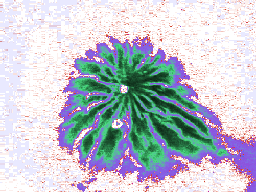
The StudyWeb Editing Team
|
|---|
In a closed circular flat cylinder, which is oscillating around its vertical axis,
a vortical pattern is observed with a periodical structure in circumferential direction.
This instability takes place in the Ekman boundary layer and is to be analysed by a linear
stability analysis of the basic flow under oscillation of the cylinder.
The pattern is given in the picture of the experimental data below :

Görtler vortices in the boundary layer of an oscillating flat cylinder
(Photo: K. G. Roesner)
|
|---|
Stability problems of rotating fluid flows are investigated, especially the flow in spherical or cylindrical geometry (see: Photo of wavy Taylor vortices). For the investigation of transient phenomena in the Taylor-Couette-system a new system of data processing for time sequences of video frames on a workstation was developed. To analyse qualitatively the flow in spherical or cylindrical gaps the method of photochromic coloring is applied. Quantitatively, the velocity fields in closed geometries are determined by a Particle-Image-Velocimetry (PIV) method which is based on an algorithm introduced by Uemura from Osaka University. (Photo: K.G. Roesner)
Wavy Taylor vortices in the gap between concentrical cylinders
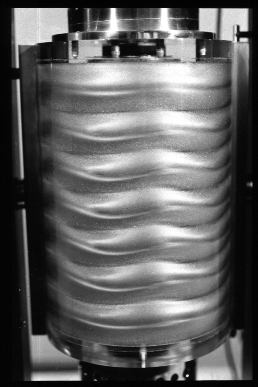
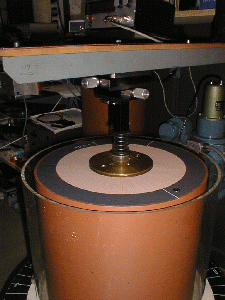
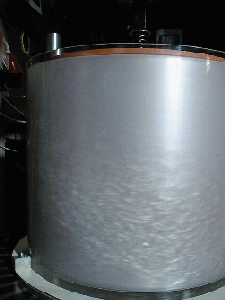
Experimental setup and the co-existence of turbulent and laminar flow regime in the cylindrical gap
Inner cylinder at rest and outer rotating


Spiral turbulence in the gap between concentric cylinders
The inner cylinder is at rest, while the outer is rotating
(Both the helical structures can be observed for the same Reynolds number)
(Photo: K.G. Roesner)
3. Vortex projectiles |
|---|
When a falling drop of a liquid impinges the surface of the same liquid, under special circumstances (height of the falling drop, surface tension, viscosity) the drop is transformed into a stable toroidal vortex which moves vertically through the liquid at rest. In the case when the drop has not a perfect spherical shape, a jet of the drop material is observed which is released from the drop material after impinging the liquid surface p e r p e n d i c u l a r to the vertical motion of the vortex ring. This "vortex projectile" (due to Zabusky's nomenclature) is a phenomenon which was found also in supernova explosions in the universe. The conditions under which this phenomenon is observed - varying the main parameter which influence this formation of vortex projectiles - is subject of an extensive experimental investigation.
If
the viscosity of the drop material is high compared with the liquid into
which the drop is falling, no merging takes place and no vortex ring is formed.
The spherical drop is deformed into a flat lens-like volume:
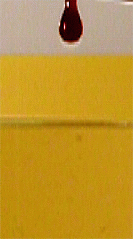
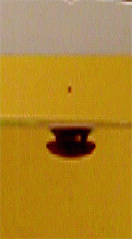
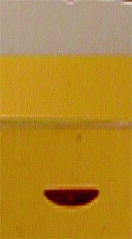
4.Transition to turbulence in a rapidly rotating centrifuge |
|---|
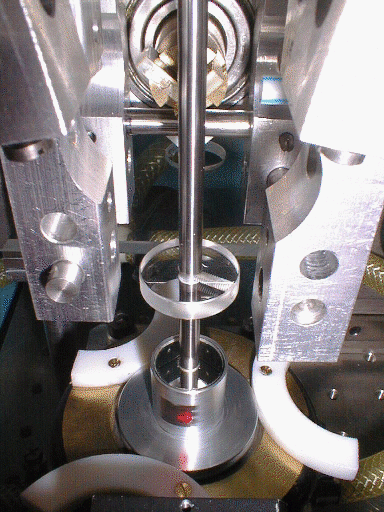
Ultracentrifuge for about 100000 r.p.m.
The laminar-turbulent transition of the air in an ultra-centrifuge is investigated when a cylinder of small diameter is positioned at the center of the rotating outer cylinder. Top and bottom are connected with the inner cylinder. The centrifuge is driven by an air-lubricated turbine at about 10^5 r.p.m. The Reynolds number of the laminar-turbulent transition is to be determined using optical methods. An interferometer is designed to analyse the flow in the gap between inner and outer cylinder of the centrifuge shown above, the signal of which is put to an earspeaker to determine the onset of turbulent flow. The cylinder with the red spot on the outer surface is designed as an air lubricated turbine (Photo: K.G. Roesner).
5. Visualisation of the bubble collapse in water by photochromic coloring |
|---|
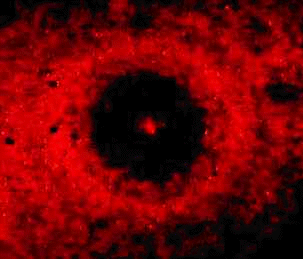
Interference pattern of a gas bubble in water (50 µm Durchmesser) Using an organic watersoluble photochromic compound the collapse of a gas bubble in water is inverstigated by observing the coloring of the liquid in the vicinity of the bubble during the periodical collapse. Observation by a video camera shows the position of the bubble and the induced secondary flow around the bubble by the advected colored fluid. In the picture above a gas bubble in water is illuminated by a laser beam giving raise to an interference pattern. This method is used to localize the position of the bubble (Photo: K.G. Roesner).
|
|---|
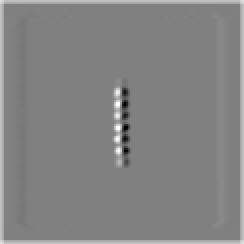


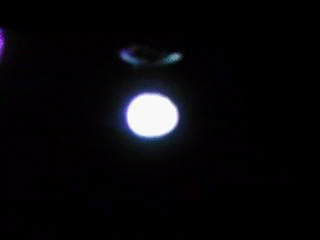
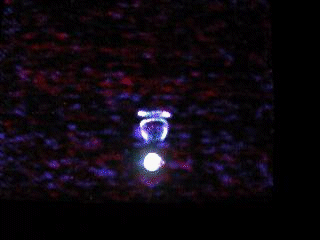
Video pictures of the burning polyethylene drops falling in air
If polyethylene is heated above the melting temperature of about 130 degrees Celsius and if ignition takes place in air, falling drops are emitting sound of about 800 Hz during the acceleration. By a video camera a typical sequence of the pictures of the drop can be seen which has periodic character. Using a high-speed camera the fine structure of the flame front behind the falling drop will be analysed. It seems that in the wake the burning ring vortex gets unstable a nd looses contact to the drop. The flame front again will attach to the drop and so is responsable for the sound frequency. Numerical simulation of the flow of the burning polyethylene gas around the falling drop is under work. The flame structure in this process is very similar to the flame in the wake of a porous spherical body which evaporates dodecane at room temperature in an oncoming stream (picture below).
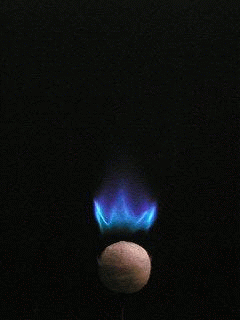
Vortical flame in the wake of a porous sphere
(Photo: K.G. Roesner)
7. Drop impact on a liquid surface under an angle of attack |
|---|
Time sequence of the interaction of a drop impinging on a surface
(Photo taken by: Dr. R. Koehler,Carl Gustav Carus-Institut)
Using a high speed camera the interaction of liquid drops of different sizes with a liquid surface is studied taking into account the influence of the angle of attack. This investigation is performed to understand the process of microencapsulation of suspended liquid drops of pharmacological character.
The whole research was sponsored by the Deutsche Forschungsgemeinschaft Bonn. (Cooperation with the Cancer Research Institute: Carl Gustav Carus-Institute,75223 Niefern-Oeschelbronn)
|
|
|---|